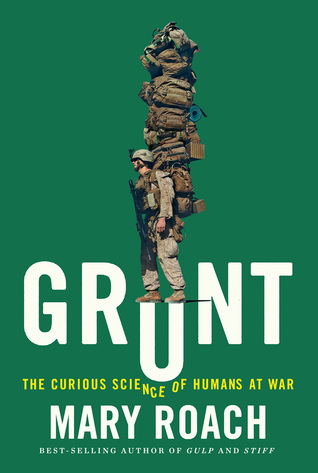 Grunt: The Curious Science of Humans at War by Mary Roach
Grunt: The Curious Science of Humans at War by Mary Roach Format: eARC
Source: supplied by publisher via Edelweiss
Formats available: hardcover, paperback, ebook, audiobook
Genres: military science, science
Pages: 276
Published by W. W. Norton & Company on June 7th 2016
Purchasing Info: Author's Website, Publisher's Website, Amazon, Barnes & Noble, Kobo, Bookshop.org
Goodreads
Best-selling author Mary Roach explores the science of keeping human beings intact, awake, sane, uninfected, and uninfested in the bizarre and extreme circumstances of war.
Grunt tackles the science behind some of a soldier's most challenging adversaries—panic, exhaustion, heat, noise—and introduces us to the scientists who seek to conquer them. Mary Roach dodges hostile fire with the U.S. Marine Corps Paintball Team as part of a study on hearing loss and survivability in combat. She visits the fashion design studio of U.S. Army Natick Labs and learns why a zipper is a problem for a sniper. She visits a repurposed movie studio where amputee actors help prepare Marine Corps medics for the shock and gore of combat wounds. At Camp Lemmonier, Djibouti, in east Africa, we learn how diarrhea can be a threat to national security. Roach samples caffeinated meat, sniffs an archival sample of a World War II stink bomb, and stays up all night with the crew tending the missiles on the nuclear submarine USS Tennessee. She answers questions not found in any other book on the military: Why is DARPA interested in ducks? How is a wedding gown like a bomb suit? Why are shrimp more dangerous to sailors than sharks? Take a tour of duty with Roach, and you’ll never see our nation’s defenders in the same way again.
My Review:
This review will be posted on Veterans Day 2016. Some years I write something about the holiday and the history behind it. My post for 2012, titled Remembrance Day, – Veterans Day, is still one of the most read items that I have ever posted.
This year I’ve chosen to review a book about the unsung heroes, scientists and researchers, who do the unglamorous and often stinky work that helps more soldiers come back as live veterans instead of dead heroes. It is research that delves into some of the odder corners of science and technology, and comes with not just a necessary dose of gallows humor, but often with a bit of slapstick as well.
Mary Roach’s latest work of nonfiction, Grunt, is all about the crazy ideas that help soldiers survive, whether on the battlefields or off. The problems and conditions that the author investigated are usually not remotely glamorous. They often delve much too deeply into realms that most of us would rather not think or talk about.
Reading the chapter about research into the causes and prevention of diarrhea over dinner was probably a mistake on my part. But she does manage to make the most mundane, and occasionally odoriferous, topics utterly fascinating.
So many of the issues explored in this book, from sleep deprivation among submariners to the potential for loss of life on SEAL teams because one member has dysentery at an inopportune moment all do impact on not just combat readiness but also on combat survivability.
Pilots in World War II were afraid of being shot down into shark-infested waters. Really. There was a lot of research into developing shark repellent – all of which failed fairly miserably. And turned out to be unnecessary. Sharks seem to be interested in prey that won’t fight back. They went after lots of dead pilots and dead or dying shipwreck victims, but healthy pilots swam for hours in shark infested waters with very few casualties. Sharks are capricious – there were a few.
The research on terrible smells was much funnier, but still had a deadly purpose. Trying to determine both which smells would completely distract enemy combatants and developing ways to deliver the stench without getting it on the messenger was hilarious. And often wrong headed in multiple ways. And yet, if an enemy could be so overcome by “Stench Soup” or the hilariously named “U.S. Government Standard Bathroom Malodor” that they can’t manage to draw their weapons, they could be disarmed and captured with much lower loss of life – at least as long as the “good guys” were wearing gas masks.
The scenarios that the author investigated ranged from the nearly sublime, uniform materials that can survive fire but not cook their wearer in the desert – to those ridiculous possibilities of stench warfare. But there is plenty of seriousness here as well, for example as she delves into the problem of making a vehicle that will keep its passengers alive if it drives over an IED. The chapters on genital transplants are medically interesting, psychologically fascinating, heartbreaking and slightly crazy making all at the same time.
But every investigation covered in this book, from the stink to the sharks to the maggots, all serve one goal. Bringing more soldiers back alive, and finding ways for them to return to civilian life with the best quality of life possible.
Reality Reading A-: This is a great read. The chapters are all compelling reading, and generally short and sweet (or stinky). There’s just enough detail not just to whet the reader’s appetite (or occasionally kill it) but also to show why the seemingly mundane is so important and worthy of government funding.
All in all, a fascinating read for the day.
